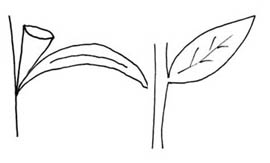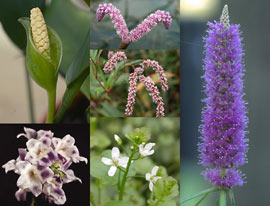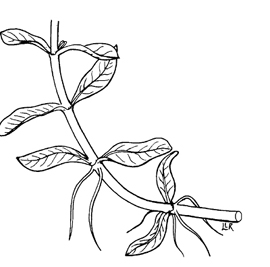Egeria Planchon
anacharis, oxygen weed, Brazilian elodea, Brazilian waterweed
Hydrocharitaceae
Blyxa (some), Elodea, Hydrilla, Lagarosiphon, Mayaca, Nechamandra, Tonina, Syngonanthus, Vallisneria (some)
South America
Egeria densa Planch.
E. najas Planch.
Egeria densa is established in natural waterways in numerous countries around the world. In many countries this species is declared a prohibited noxious weed.
Egeria densa is an environmental weed in several countries where it is introduced.
submersedsubmersed:
see submerged
stem plantstem plant:
(n) (a term used in the aquarium and pond plant trade) having an elongate stem (as opposed to a compact stem)
, floating or rooted
Perennial. Elongate stems bear leaves in densely spaced whorls of 4-5 (particularly dense near apexapex:
(n) the point farthest from the point of attachment; the tip (often pointed)
). Leaves scalescale:
(n) any thin, usually small and dry, membranous to leathery bract
-like, sessilesessile:
(adj) attached directly, without a stalk
 , linear, slightly recurvedrecurved:
, linear, slightly recurvedrecurved:
(adj) curved downward or backward
, with single mid-vein; marginmargin:
(n) edge; rim
finely serrateserrate:
(adj) (of a leaf margin) bearing sharp teeth pointing forward or to the apex
 . Inflorescenceinflorescence:
. Inflorescenceinflorescence:
(n) the arrangement of flowers on the floral axis
 axillary, of unisexualunisexual:
axillary, of unisexualunisexual:
(adj) (of a flower) with either stamens (male) or pistils (female) but not both; consisting of only male or female flowers
flowers. Female and male flowers similar in shape, opening above water surface; sepals 3; petals 3, white. Dispersal by seed and stem fragments. Adventitiousadventitious:
(adj) of an organ growing where it is not normally expected, e.g., roots growing from a stem
 roots (unbranched) and laterallateral:
roots (unbranched) and laterallateral:
(adj) on or pertaining to the side of an organ or structure
branches grow only from double nodes (specialized nodes separated by a shortened internodeinternode:
(n) section of a stem between two nodes
 ) typically spaced along stems at 6-12 node intervals. Only fragments containing a double node develop into new plants.
) typically spaced along stems at 6-12 node intervals. Only fragments containing a double node develop into new plants.
still and slow-moving water bodies such as large rivers, ponds, and lakes
Egeria densa is one of the most commonly sold aquatic plants for aquaria and ponds; it is marketed as a water oxygenator. Egeria najas (the only other species in the genus) is relatively uncommon in the trade and can be distinguished from E. densa by its narrower stems, leaves usually in 5-merous whorls (4-merous in E. densa), usually longer and more strongly recurvedrecurved:
(adj) curved downward or backward
leaf blades, and more prominent serrations on the leaf bladeblade:
(n) (syn. lamina) the flat, expanded part of a leaf, frond, or petal (excluding, e.g., the petiole)
 marginmargin:
marginmargin:
(n) edge; rim
. The white pedicillate flowers produced well above the water surface are a distinctive characteristic of this genus among plants with similarly looking foliage and growth forms.